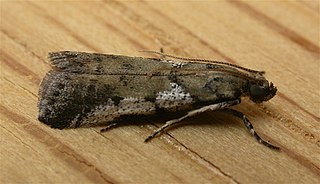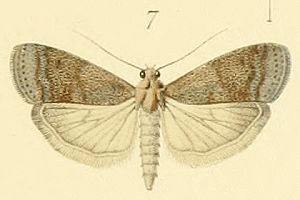
Assara holophragma is a species of moth of the family Pyralidae. It is found in Australia.
Assara albicostalis is a moth of the family Pyralidae. It has a wide distribution and has been recorded from India, Sri Lanka, Thailand, Sabah, the Philippines, Taiwan, Sulawesi, Australia, Fiji, Tahiti, Samoa, Hawaii and the Marquesas. This is the type species of genus Assara.

Assara conicolella is a species of snout moth in the genus Assara. It was described by Alexandre Constant in 1884 and is known from France, Corsica and the Iberian Peninsula.
Assara aterpes is a species of snout moth in the genus Assara. It was described by Alfred Jefferis Turner and is found in Australia.
Assara cataxutha is a species of snout moth in the genus Assara. It was described by Alfred Jefferis Turner in 1947 and is found in Australia.
Assara chionopleura is a species of snout moth in the genus Assara. It is found in Australia.
Assara leucarma is a species of snout moth in the genus Assara. It was described by Edward Meyrick in 1879 and is found in Australia.
Assara linjiangensis is a species of snout moth in the genus Assara. It was described by Yan-Li Du, Hou-Hun Li and Shu-Xia Wang in 2002 and is known from China.
Assara melanomita is a species of snout moth in the genus Assara. It was described by Alfred Jefferis Turner in 1947 and is found in Australia.
Assara microdoxa is a species of snout moth in the genus Assara. It was described by Edward Meyrick in 1879, and is known from Australia.
Assara odontosema is a species of snout moth in the genus Assara. It was described by Alfred Jefferis Turner in 1913 and is found in Australia.
Assara proleuca is a species of snout moth in the genus Assara. It was described by Oswald Bertram Lower in 1903 and is found in Australia.
Assara semifictile is a species of snout moth in the genus Assara. It was described by Alfred Jefferis Turner in 1913 and is found in Australia.

Assara subarcuella is a species of snout moth in the genus Assara. It was described by Edward Meyrick in 1879 and is found in Australia.
Assara tumidula is a species of snout moth in the genus Assara. It was described by Yan-Li Du, Hou-Hun Li and Shu-Xia Wang in 2002 and is known from China.
Assara halmophila is a species of snout moth in the genus Assara. It was described by Meyrick in 1929. It is found on the Marquesas Islands and the Society Islands.

Bradley Mark Walker is an American politician and pastor from the state of North Carolina. A Republican, Walker has represented North Carolina's 6th congressional district in the United States House of Representatives since 2015. In 2017, Walker was elected to head the Republican Study Committee.

Tom Walker is a Scottish singer-songwriter. He rose to fame after the release of his single "Leave a Light On", which peaked at number 7 on the UK Singles Chart.







